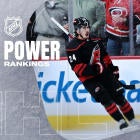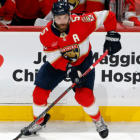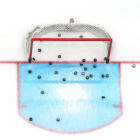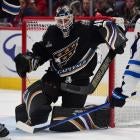
There’s a certain level of violence that is inherent in postseason hockey. It’s part of the mystique that fuels the narrative of the grinding, grueling Stanley Cup Playoffs, which is unlike anything in sports. But in order to protect those important optics of grit, sacrifice and doing whatever it takes to win the Stanley Cup, the NHL needs help from its officials and they've been getting it this year.
“Let them play,” is a common phrase uttered each spring as the playoffs come around. That’s code for, don’t call penalties unless it's blatantly obvious. This year has been no different. You need not look further than Monday night when both games featured questionable hits that luckily did not result in injuries to the players on the receiving end and they came within the same hour.
In Detroit, Red Wings defenseman Niklas Kronwall delivered one of his trademark devastating hits that often toes the line of acceptable. However, as replays showed, Kronwall left his feet before contact and his forearm clocked Tampa Bay Lightning forward Nikita Kucherov in the head. It was at least charging and at worst an illegal check to the head.
There was no penalty on the play, but for the first time this postseason, the NHL’s Department of Player Safety decided to actually have a hearing to review the hit. That comes Tuesday and could end up costing Kronwall his spot in the Game 7 lineup, unless they determine that leaping into an opponent’s head is worthy only of a fine, or worse, nothing. That’s still a possibility.
Not long after Kronwall delivered the blow in Detroit, Alex Ovechkin of the Washington Capitals delivered a hit from behind on New York Islanders defenseman Thomas Hickey in the second period go Game 7 between the two clubs. Ovechkin saw numbers all the way and cross-checked Hickey into the boards, planting him face-first into the glass. Every kid that plays hockey is going to be shown that hit as a perfect example of what not to do. The only people who were fine with it were Ovechkin and the guys in stripes, apparently. There was no penalty of any kind on the play.
GIF: Another angle of the Ovechkin hit that went unpenalized pic.twitter.com/hpIVz9uBJN
— Pete Blackburn (@PeteBlackburn) April 28, 2015
Ovechkin’s hit may not be worthy of a suspension, but it’s a clear penalty and when dangerous plays like that go unpunished, it’s a green light for the players to continue pushing the boundaries.
That Capitals-Islanders pushed the boundaries throughout their first-round series, as both teams tested its limits. There was the Tom Wilson hit on Lubomir Visnovsky that knocked the Isles defenseman out of the series with what is believed to be a concussion. Two minutes for charging, and nothing more.
The Wilson penalty was about as close to the borderline as you can get. I don't necessarily believe it was absolutely a suspension, but there was a good case for it to be more than a minor penalty. The fact that Visnovsky was injured on the play only increased the scrutiny.
Then what of the game-winning goal in Game 6, there was a scrum by the bench that included about 300 (rough estimate) penalties on one play with cross-checks, trips, roughing and Johnny Boychuk just straight up body-slamming Joel Ward. Play continued, the Isles scored and then forced a Game 7.
Though the end result was a goal on the play, it came amid a wrestling match instead of a hockey game.
And let’s not forget about P.K. Subban’s vicious slash on Mark Stone in Game 1 of the series between the Montreal Canadiens and Ottawa Senators. The officials actually got that one right, but the rulebook specifically dictates a major penalty and game misconduct for a slash that results in injury. That’s black and white. In NHL discipline, there’s a lot of grey area and in the Stanley Cup Playoffs, the officials practically live in it.
I love the physicality of playoff hockey, I really do. But the fact that the standard of officiating changes from one portion of the season to the playoffs is beyond ridiculous. The game is what it is, the rules are what they are. By letting so much go that isn’t let go in the regular season, the green light is on for NHL players to up the violence to a potentially dangerous degree, while also slowing the game down during what is supposed to be the most exciting time of the year.
“It’s playoff hockey,” you might say. It is indeed, and it’s supposed to be harder than the regular season, but not at the expense of the rules that are designed to help maintain the flow of a game and most importantly to protect the players.
You can’t really blame the officials for this, though. This is apparently what the audience wants and it doesn't appear as though the league has any interest in stepping in. These games are supposed to hurt, the playoffs are a war of attrition, etc.
Hockey remains a sport where a player is always at risk. They wear knives on their feet, the boards don’t give, the 240-pound behemoth skating head on is about to deliver a hit at a similar force to a car accident. The players know these risks and are probably more aware than ever what can happen to them if they get hit the wrong way or what they can do to someone else. Of course, they willingly take these risks on “because it’s the Cup.”
That’s why the officials’ job and the job of the Department of Player Safety is so important. Their duty is to protect the players from themselves because literally no one else will. No one else really has the power. Not even the team medical staffs, which have two jobs – look out for the player and get him back on the ice as soon as humanly possible.
If a referee lets a trip go here, or a hold go there, no one’s usually the wiser except for the fan base for the 10 minutes after the call is missed. However, with each missed call no matter how large or small, they’ve pushed the line a little further back. And as we saw in Game 7 between the Islanders and Capitals, the line was actually nearly obliterated.
It wasn’t until there was under three minutes remaining in regulation of a one-goal game that the referees finally called the first penalty of the entire night. Of course it was on the team that was leading. Capitals defenseman John Carlson was whistled for roughing after he got his hands up on Islanders forward Casey Cizikas.
It was no doubt a penalty, and the right call, but that came after so much else was missed. When the players are given that much rope, how could they expect a penalty to come at that time in a one-goal elimination game?
The call for more stringent officiating -- or more appropriately, proper officiating -- isn't just about protecting players, though that should be the highest priority. It's also about what it does to the quality of the on-ice product. No one wants to see a penalty-filled affair, but they also don't want to see the clutch and grab hockey that dragged the league down in the late 1990s and early 2000s.
As James Mirtle noted in the Globe & Mail, power plays are down in the 2015 Stanley Cup Playoffs:
This year, with only one game left to play, there have been slightly under six power plays per game, which is down slightly from during the year.
But it’s a figure that is way down from 2012 when it was 6.6, which was way down (20 per cent) from 2009 and (43 per cent) from 2006, when there were nearly double that.
There has been an average of 4.7 goals per game with one game remaining in the opening round. That makes for tight games and great finishes, but when it is born out of the allowance of obstruction and subtle infractions meant to slow down opposing players, the game gets dulled down.
The speed and intensity of the Stanley Cup Playoffs is as big a part of what makes them so thrilling as the physicality. By changing the standard of officiating, and what is and isn't a penalty this time of year, the high level of risk players are asked to take on is increased, the on-ice product suffers, the league's credibility suffers and if it gets bad enough, fan interest may eventually suffer, too.
![[object Object] Logo](https://sportshub.cbsistatic.com/i/2020/04/22/e9ceb731-8b3f-4c60-98fe-090ab66a2997/screen-shot-2020-04-22-at-11-04-56-am.png)

















